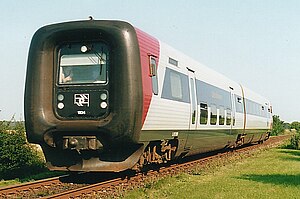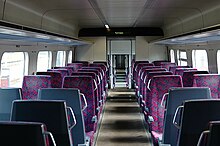IC2 (Danish private railways)
| IC2 | |
|---|---|
|
IC2 multiple unit of the Lollandsbane near Krungerup.
|
|
| Numbering: | MF 1001-1004, 1021-1023, 1041-1046 FS 1101-1104, 1121-1123, 1141-1146 |
| Number: | 13 |
| Manufacturer: | Adtrance |
| Year of construction (s): | 1997 |
| Gauge : | 1435 mm ( standard gauge ) |
| Length over buffers: | 41.0 m |
| Length: | 20.5 m |
| Height: | 3.85 m |
| Width: | 3.10 m |
| Top speed: | 140 km / h |
| Installed capacity: | 2 × 420 hp |
| Acceleration: | 0.8 m / s 2 |
| Motor type: | 2 diesel engines |
| Power transmission: | mechanically |
| Train heating: | air conditioning |
| Seats: | 124 |
| Floor height: | 1.30 m (railcar) 0.60 m (control car) |
The IC2 (former designation RL2D) is a Danish , two-part diesel multiple unit for regional traffic, which was delivered in 1997 by Adtranz in Randers (today part of Bombardier ) in 13 copies to Danish private railways.
The train is derived from the DSB MF series , also known as IC3, and has the same flexible and easily recognizable front coupling system as the other Flexliners from DSB. In contrast to the DSB MF, the IC2s are equipped with a low-floor trolley, an additional door section and water-cooled instead of air-cooled motors. The fuel consumption is 0.8 liters per km. The waste heat from the engines is used to heat the train with the cooling water.
The IC2 multiple units were the first major replacement for the Y- multiple units widely used by private railways . The price per train was 18 million Danish kroner. The first multiple unit was delivered to Gribskovbane in April 1997. Today the multiple units of the IC2 series are the only type of train on the Lollandsbane . At the same time, the multiple units of the IC2 series are the second most common type of train of the Lokaltog railroad company's fleet of only three train types . Although the multiple units of the series IC2 and DSB MF can be mechanically coupled to one another, the IC2 multiple units cannot control the other types of Flexliner.
background
The IC2 multiple units are a further development of the DSB MF. They were designed for use on private railways and on certain local routes, as is to be understood by the term "RL2D", which means "Regional Local 2 Diesel", where 2 is the number of cars. Among other things, the manufacturer hoped that DSB would buy IC2 multiple units for the Odense – Svendborg line . The first draft for the IC2 train was almost an IC3 train with no intermediate car and no engine equipment in one car. However, the private railways were not satisfied with this solution and wanted a number of changes. These changes resulted in the current appearance. Despite the similarity with IC3 / IR4 , IC2 cannot correspond to these train types. This is because the interface module that the computer systems use to communicate is not installed. It was assumed that it is still not being used and therefore not worth the money. However, the module is available and can be retrofitted.
Interior
The railcars have a driver's cab, followed by a flex area with eight folding seats (just above the front bogie) and immediately afterwards a 90 cm wide entry area. This is followed by a toilet and finally a passenger section. The control cars of the FS series are equipped with a section with six seats above the shared Jakobs bogie of the railcar and control car. Immediately after this bogie, the floor is lowered to the normal platform height (about 60 cm above the upper edge of the rail) and provided with a door area, then a passenger area, a flex area with four folding seats and parking spaces for bicycles, prams or standing passengers and another door area. Here is the third and last bogie of the train, and the floor of the passenger area above with 6 seats and the adjoining driver's cab is raised to normal height again. As with the Öresund trains, the cabs only have a window in the side of the cab, but no door. The driver's cabs are accessed via the nearest door area.
business
The IC2 multiple units were delivered in 13 copies. The first multiple unit - MF 1041 with the name Mor Grib - arrived at Gribskovbane on May 20, 1997 and was put into service on June 26. The multiple unit went on presentation trips in Sweden and was presented at the Nordic Rail trade fair on September 30, 1997 in Jönköping .
Frederiksværkbane's first IC2 multiple unit was MF 1044.
The 13 trains were originally distributed between the five companies Lollandsbanen, Odsherredsbanen / Tølløsebanen and Gribskovbanen / Frederiksværkbanen. The last six trains were moved to Lollandsbane in 2007, which merged with Vestsjællands Lokalbaner and Østbanen to form Regionstog A / S in 2009. Since the merger of Regionstog A / S and Lokalbanen A / S to form Lokaltog A / S on July 1, 2015, all multiple units have been owned by this railway company.
| Railway administration | Motor vehicle | Control car | Delivery year | Remarks |
|---|---|---|---|---|
| Lollandsbanen (LJ) | LJ MF 1001-1004 RTOG MF 1001-1004 |
LJ FS 1101-1104 RTOG FS 1101-1104 |
1997 | 2009 to Regionstog A / S |
| Odsherreds Jernbane (OHJ) / Høng-Tølløse Jernbane (HTJ) | OHJ-HTJ MF 1021-1023 VL MF 1021-1023 RTOG MF 1021-1023 |
OHJ-HTJ FS 1121-1123 VL FS 1121-1123 RTOG FS 1121-1123 |
1997 | 2003 to Vestsjællands Lokalbaner A / S 2009 to Regionstog A / S |
| Gribskovbanen (GDS) / Frederiksværkbanen (HFHJ) | GDS-HFHJ MF 1041-1046 LJ MF 1041-1046 RTOG MF 1041-1046 |
GDS-HFHJ FS 1141–1146 LJ FS 1141–1146 RTOG FS 1141–1146 |
1997 | 2007 to Lollandsbanen 2009 to Regionstog A / S |
Names
Of the 13 multiple units delivered, four were given names. The multiple units 1021-1023 were named after the constellations Leo ( Løven ), Hercules ( Hercules ) and Orion ( Orion ), while the first multiple unit 1001 was named Mor Grib , an allusion to Gribskov . This no longer bears the name.
Individual evidence
- ↑ a b IC2-tog til privatbanerne | Ingeniøren.dk
- ↑ Birgitte Marfelt: IC2 til privatbanerne. April 19, 1996, accessed June 11, 2019 (Danish).
- ^ Lollandsbanen. Motor locomotives. In: jernbanen.dk. Retrieved June 22, 2019 (Danish).
- ^ Lollandsbanen. Person-, post- og rejsegodsvogne. In: jernbanen.dk. Retrieved June 22, 2019 (Danish).
- ↑ a b c Regionstog A / S. Motor locomotives. In: jernbanen.dk. Retrieved June 22, 2019 (Danish).
- ↑ a b c Regionstog A / S. Person-, post- og rejsegodsvogne. In: jernbanen.dk. Retrieved June 22, 2019 (Danish).
- ↑ Odsherred Jernbane - OHJ - Odsherredsbanen. Motor locomotives. In: jernbanen.dk. Retrieved June 22, 2019 (Danish).
- ↑ Odsherred Jernbane - OHJ - Odsherredsbanen. Person-, post- og rejsegodsvogne. In: jernbanen.dk. Retrieved June 22, 2019 (Danish).
- ^ Vestsjællands Lokalbaner A / S - VL. Motor locomotives. In: jernbanen.dk. Retrieved June 22, 2019 (Danish).
- ^ Vestsjællands Lokalbaner A / S - VL. Person-, post- og rejsegodsvogne. In: jernbanen.dk. Retrieved June 22, 2019 (Danish).
- ↑ Gribskovbanens Driftselskab - GDS. Motor locomotives. In: jernbanen.dk. Retrieved June 22, 2019 (Danish).
- ↑ Gribskovbanens Driftselskab - GDS. Person-, post- og rejsegodsvogne. In: jernbanen.dk. Retrieved June 22, 2019 (Danish).
- ↑ Odsherred Jernbane - OHJ - Odsherredsbanen. Motor locomotives. In: jernbanen.dk. Retrieved June 22, 2019 (Danish).
- ↑ Odsherred Jernbane - OHJ - Odsherredsbanen. Person-, post- og rejsegodsvogne. In: jernbanen.dk. Retrieved June 22, 2019 (Danish).

